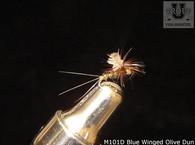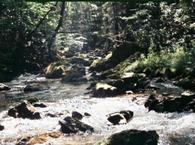
These caddisflies need plankton to survive and acidic, freestone streams that have little plankton are about the only trout streams that doesn't have them. To make this simple for you, consider this. If you find the rocks in the stream you are fishing are slick, and you have trouble wading without slipping, you can rest assured that there will be a good population of net-spinning caddisflies in the stream. In the Eastern United States and parts of the Mid-west, most of these net-spinners will be Ceratopsyche species, which are the Cinnamon Caddisfles. There will also be some Spotted Sedges, or members of the Hydropsyche genus. Some anglers call the Cinnamon Caddis "Spotted Sedges'. There's little difference in them. The common names are easily confused because it depends on the extent and contrast of the spots that appear on their wings. Most all of the species within the big family of net-spinner caddisflies have some spots on their wings.
Keep in mind that where the caddisflies are plentiful, they are very important. The different species hatch at different times from about the middle of April (earlier this year) until the middle of September. When they are not hatching, the larva are often available for trout to eat. They stay under little open shelters (not cases) they build on the rocks, but eat the food they catch in their little silk nets. When fully open, these nets are about the size of a pea at the very largest. If you pick a rock up from the stream they will collapse and you will probably not be able to see them. In the current they remain open much like a parachute. The larvae repel down the silk line to the nets to feed and that's when the trout eat them the most.
Various methods of imitating the larvae hanging at the end of the silk line have been developed over the years, but we have not had that good of results with them, and we do not recommend that approach. You may want to try it and come to your own conclusion about it. We do better just fishing our Perfect Fly larva imitation on the bottom. It looks almost exactly like the real thing. The legs and tail of the fly will move around some in the current like the real ones.
You want to fish this fly in the riffles with a weight attached a few inches above the fly. We use small split shot. An up and across presentation works best in rough water such as pocket water and riffles. Allow the fly to swing all the way around and downstream keeping it near the bottom. If the water is smooth, you may want to use a longer down and across presentation. Mend your line as soon as the fly hits the water to help get it down to where the split shot will bounce along the bottom. Allow the fly to swing all the way around, directly downstream of your position. Step downstream and repeat the cast to cover new water.
By the way, this fly is deadly on all the tailwaters in the Smoky Mountains area as well as most other tailwaters. Fish it when there isn't a hatch taking place, which of course, is most of the time. You will want to switch to a pupa when a hatch begins.





